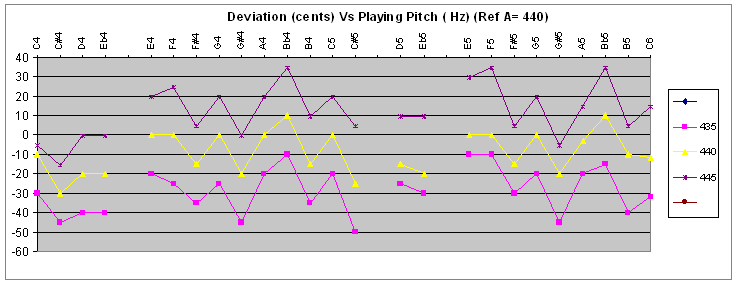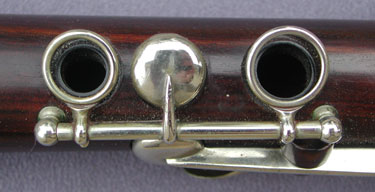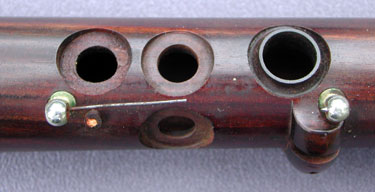The bore
Just as the scale and intonation follow normal
Improved era practice, so does the bore, shown in hot pink below
So far, Clinton bores seem to fall into just two
camps:
-
8-key flutes (e.g. in my Research
Collection), 8-keys with brille (ie early Equisonant like the one under
study), and the Flute for India follow a generally Rudall & Rose
pattern.
-
Multi-key Equisonants and the 1851 Potter
Clinton follow the general lines of Rose's New Conoidal Bore.
The difference between the two groups is quite
significant and is best noted at the foot, where group 1 goes below
11mm, while group 2 are around 12.5.
It's interesting and not insignificant that he opted to have models in
the two major pre-existing camps. I and lot's of makers do the
same today. It's also interesting that he did not seem to be
interested in the small bores used by Boehm and by Rudalls for their
early Boehm flutes. Far too wimpy for the English market.

A bit rough!
Indeed, there are many points of workmanship on
this flute that are less good than we are used to seeing from the house
of Clinton:
-
as mentioned, the pad seats are just flat
bottomed holes, and not always concentric with the hole (not that
concentricity is essential, but it suggests the use of interim tooling)
-
there are no striker plates under the springs
-
the cork dot buffer for G# key is not under
the rivet (and there is no obvious sign of the rivet having been moved)
-
the keys are more crudely made and not so
well finished
-
the body bore wanders towards one side in
the middle.
-
the Eb key needed a bit more metal taken out
from underneath to stop it hitting the wood before the pad bottoms
Indeed, this last point possible explains why
the flute seems relatively unused. It's quite likely that the Eb
key never really seated well, making the lowest notes hard to play and
unsatisfying.
Playing qualities.
Given the Improved era dimensions, the flute plays pretty much like an
average flute from the first half 19th century. As we've seen in
the work of other makers, clearly strong demand remained for flutes of
this kind, even though by the time this one was made, Pratten had
moved the goal posts considerably. In this context it's good to
remember that the market leaders of the Improved period, Rudall &
Rose continued to make Improved style flutes for 50 or more years after
Pratten's development.
Earlier than the number suggests?
Now you would hope that such issues as mentioned
above might be sorted out by the time we reach flute no 113. But
it's worth noting that this is the earliest Clinton & Co flute
number so far reported. Is it possible that Clinton didn't start
at No 1, but perhaps at whatever number he and Potter had reached
before Clinton went out on his own? We know that is at least
91. That could make this a very early Clinton & Co flute
indeed and would explain the slightly rough edges.
Common Features
Comparing the three early-number 8-key flutes so
far reported, we see:
-
all single-piece long-body style
-
all have brille
-
all have the Long F turned up in the
Nicholson style
-
all have the Siccama-style rounded end
termination.
Market Niche?
So we're looking at a flute that appears to be
one of the new fangled Perfected style, such as Boosey & Co were
making under the Pratten's Perfected label, but that plays in the
manner of an Improved era flute, still being made by Rudall & Rose
and most of the other makers of the time. And with the Brille to
fix up the flat c# problem. My guess this was aimed at amateur
users rather than professionals, who would benefit more from a higher
pitched flute. Amateur purchasers always outnumber professionals,
as much now as then, so this was common sense marketing.
Training, and cash flow augmentation?
It would be reasonable to imagine that Clinton
was meeting other goals or indeed needs in releasing these
straightforward flutes. It must have cost a lot to set up his
flute-making operation, cold-bloodedly and from a standing start.
And it would take some further time and effort to develop the more
advanced models we normally associate with Clinton. The set-up
costs have to be serviced, and salaries met until the new models hit
the market and start earning their keep.
You could also imagine that training of new staff
would also be an issue. Clinton was probably lucky enough to be
able to attract some experienced staff (he was a flute professor after
all, not a maker), but staffing the whole operation by pilfering
personnel from other companies would be more difficult and more
expensive. He probably started with one or so experienced makers,
and a sign in the window, boy wanted. Making some simple flutes
up front would be a more gentle introduction than making a complex
multi-key.
Equisonant or not?
So is it fair to call these simple flutes
Equisonant? From our view in retrospect, it might seem a little
disappointing - we've come to associate that name with the multi-key
flutes that set Clinton apart from all the other makers. But, we
have to remember it's Clinton's name, and his to do what he likes
with. Pratten after all had a suite of flutes he called Pratten's
Perfected - everything from a simple 8-key wooden conical to a 17 key
metal cylinder - why shouldn't Clinton employ a similar marketing tag?
And then there is that Brille - the additional
keywork to sharpen up c#. It's clear in all his designs that
Clinton loathed the flat c# normally associated with 8-key flutes and
even when he gets to make some 8-keys, he does something about
it. The brille is not new in England, Siccama at least had used
it prior to Clinton, and it had passed on to some of Pratten's models.
|





